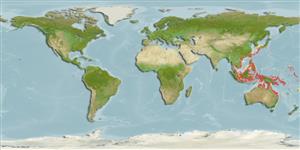分类 / Names
俗名 | 同种异名 | Catalog of Fishes(属, 种) | ITIS | CoL | WoRMS | Cloffa
Teleostei >
Tetraodontiformes (Puffers and filefishes) >
Monacanthidae (Filefishes)
Etymology: excelsus: Name meaning 'elevated', referring to it prominently elevated dorsal and ventral profiles..
Environment: milieu / climate zone / depth range / distribution range
生态学
海洋 礁区鱼类; 深度上下限 8 - 25 m (Ref. 90102). 热带
Western Pacific: northern Australia to southern Japan.
西太平洋: 澳洲北部到日本南部。
Length at first maturity / 大小 / 重量 / 年龄
Maturity: Lm ?, range 2 - ? cm
Max length : 2.5 cm TL 雄鱼/尚未辨别雌雄; (Ref. 2334)
简单描述
检索表 | 型态特徵 | 形态测量图
背棘 (总数) : 2; 背的软条 (总数) : 22 - 24; 臀鳍软条: 20 - 22; 脊椎骨: 20. Diagnosis: Extremely small size at maturity (1.5 cm SL). Prominently elevated dorsal and ventral profiles. Extremely long bristles on caudal peduncle of male, projecting posteriorly to behind middle of caudal fin. Low fin ray counts (D.22 to 24; A.20 to 22; P.10) (Ref. 35708).
鉴别: 非常地成熟时 (1.5 公分 SL) 的体型小. 显著升高背部与腹的轮廓。 非常长在雄鱼的尾柄上的刚毛, 突出的在后部地在尾鳍的中央后面。 低的鳍鳍条计算 (D.22 到 24; A.20 到 22; P.10).(参考文献 35708)
描述: 身体短与非常深的。 齿不平坦的, 尖的末梢部地。 头部与身体白褐色, 覆盖着许多小的褐色斑点 (参考文献
Inhabits sheltered coastal habitats, usually in areas with mixed low reef and sparse seagrass (Ref. 48637).
栖息于掩蔽的海岸栖息地, 通常在区域有混合的低礁与稀疏的海草.(参考文献 48637)
Life cycle and mating behavior
Maturities | 繁殖 | Spawnings | Egg(s) | Fecundities | 仔鱼
西太平洋: 澳洲北部到日本南部。
Randall, J.E., G.R. Allen and R.C. Steene, 1990. Fishes of the Great Barrier Reef and Coral Sea. University of Hawaii Press, Honolulu, Hawaii. 506 p. (Ref. 2334)
人类利用
工具
特别资料
下载 XML
网络资源
Estimates based on models
Preferred temperature (Ref.
123201): 25.2 - 29.3, mean 28.6 °C (based on 1897 cells).
Phylogenetic diversity index (Ref.
82804): PD
50 = 0.6250 [Uniqueness, from 0.5 = low to 2.0 = high].
Bayesian length-weight: a=0.01995 (0.00943 - 0.04220), b=2.93 (2.75 - 3.11), in cm total length, based on LWR estimates for this (Sub)family-body shape (Ref.
93245).
营养阶层 (Ref.
69278): 3.0 ±0.4 se; based on size and trophs of closest relatives
回复力 (Ref.
120179): 高度, 族群倍增时间少于 15个月 (Preliminary K or Fecundity.).
Fishing Vulnerability (Ref.
59153): Low vulnerability (10 of 100).
